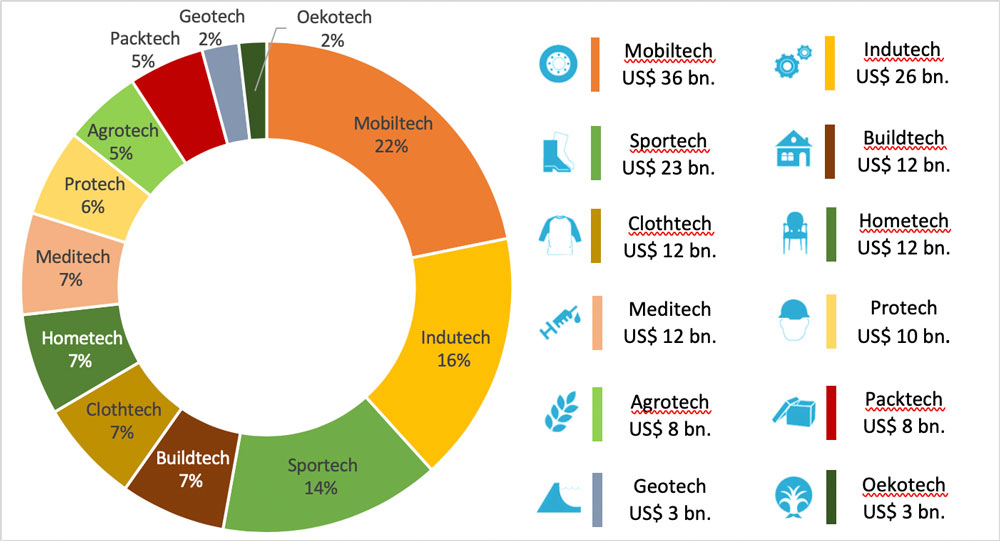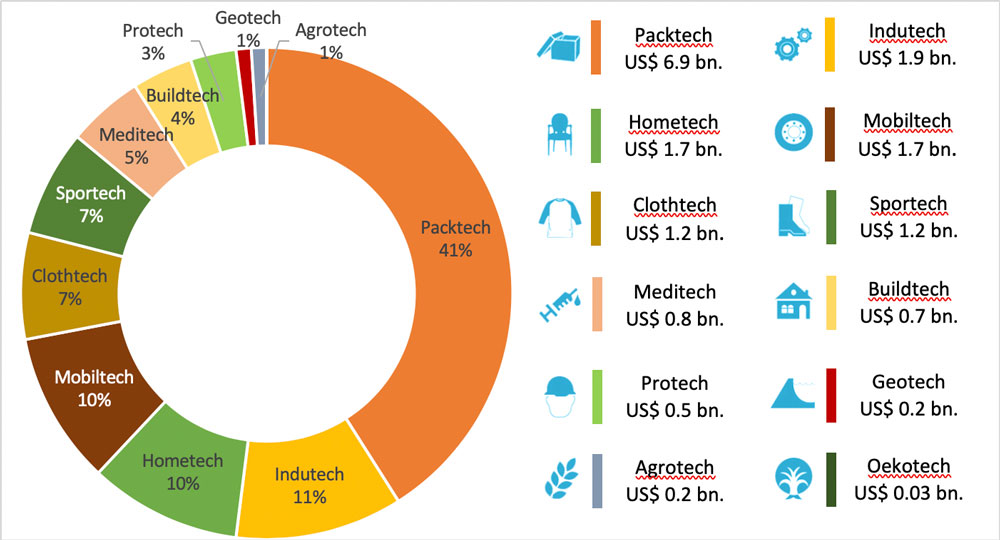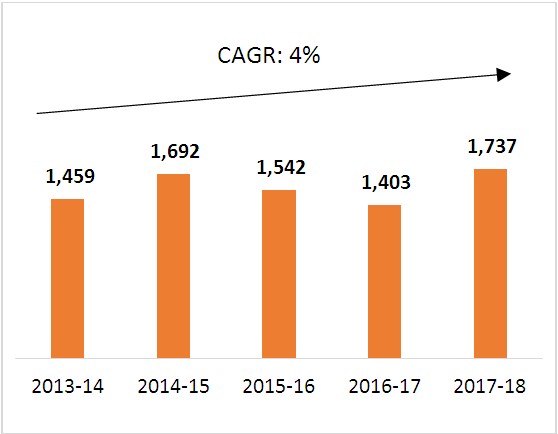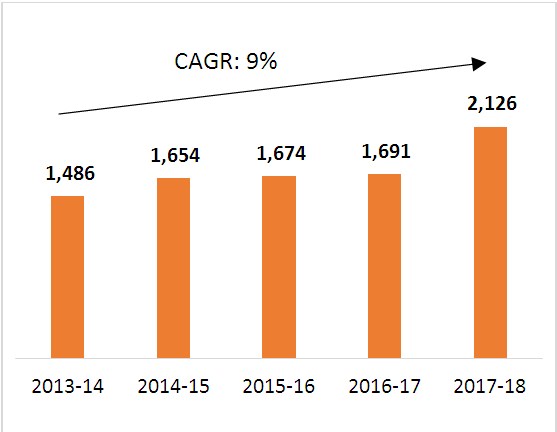Technical textiles refer to textile materials primarily used for their technical performance and functional properties. Based on product characteristics, functional requirements and end-user applications; technical textiles products have been classified into 12 categories, viz., Agrotech (Agro-textiles), Buildtech (Construction Textiles), Clothtech (Clothing Textiles), Geotech (Geo-textiles), Hometech (Domestic Textiles), Indutech (Industrial Textiles), Mobiltech (Textiles used in transport; automotive and aerospace), Oekotech (Ecological Protection Textile), Packtech (Packaging Textiles), Protech (Protective Textiles), Sportech (Sports Textiles) and Meditech (Medical Textiles). Technical textiles is a large and growing sector that supports a vast array of industries. The demand for a variety of these products has increased as a result of their rising base of applications in end-use industries such as automotive, construction, healthcare, protective clothing, agriculture, sports, etc.
In the Indian scenario, technical textiles is one of the fastest growing segments of the textile industry, registering a double-digit growth year on year. This blog elaborates the current scenario of technical textiles and highlights India’s growth potential in this sunrise sector.
The global market for technical textiles is pegged at US$ 165 billion in 2018. Mobiltech, Indutech and Sportech are the largest segments of the global industry, together accounting for 52% of the market. Europe and China together account for more than 50% of global technical textile production while India accounts for approximately 5% of the production.
Figure 1: Segmentation of Global Technical Textiles Market (2018)

Data Source: Wazir Analysis
There has been a shift in the way technical textiles’ demand is being perceived. Conventionally, North America and Europe have been the major markets for technical textiles. However, the industry in the developed countries is maturing in a significant way. Recently, the demand from Asia Pacific has eclipsed the global demand for technical textiles accounting for approximately 40% of the total consumption.
In developing economies like China and India, technical textiles are expected to emerge as a growing production as well as consumption base. The improvement in technology, rising demand from various industries and increasing support from government policies are anticipated to fuel the market growth in this sector.
The global market for technical textiles is expected to grow at a CAGR of 4% and attain a size of US$ 220 bn. by 2025. Growth of end user industry in some specific segments are also driving the usage of technical textiles globally. Some of the examples include the below:
Figure 2: Major Markets for Technical Textiles

Data Source: Wazir Analysis
Globally technical textiles market features large research and development investments made by market players that have resulted in novel products and innovation. Major players such as Ahlstorm Corporation, DuPont, Asahi Kasei, Freudenberg, etc., have been taking enthusiastic steps to create new applications in terms of customer demand and provisions.
India is emerging as a significant player in the technical textiles industry and contributes to approximately 10% of global consumption. India’s technical textiles market is valued at US$ 17 billion, which has been growing a CAGR of 12% since the last five years.
Figure 3: Segmentation of Indian Technical Textiles Market in 2017-18

Data Source: DGCI&S
India is the net importer of technical textile products. India exported technical textile products worth US$ 1,737 million in 2017-18, while the imports for the same stood at US$ 2,126 million. India is a key exporter of certain commoditized products such as sacks & bags, flexible intermediate bulk containers (FIBCs), jute carpet backing, hessian, etc. The technology-intensive products such as airbags, tyre cord fabric, glass fibre, etc., are imported to a large extent.
Figure 4: India’s Exports of Technical Textiles (Values in US$ Million)

Data Source: DGCI&S
Figure 5: India’s Imports of Technical Textiles (Values in US$ Million)

India has emerged as a key market for technical textile products. The Indian technical textile industry is expected to grow at a CAGR of 16% to reach US$ 50 bn. by 2025. Some of the key factors that will drive the growth of technical textiles industry in India are:
While the overall Indian technical textiles market is growing, segments like Mobiltech, Indutech, Sportech and Hometech are showing high growth potential.
Table : Key Growing Segments (Values in US$ Million)
| Segment | 2017-18 | 2024-25 (P) | CAGR | |
| Mobiltech | ||||
| 1 | Tyre Cord Fabric | 1,000 | 2,500 | 14% |
| 2 | Tyre Cord Fabric | 1,000 | 2,500 | 14% |
| 3 | Tyre Cord Fabric | 1,000 | 2,500 | 14% |
| Indutech | ||||
| 1 | Glass Fibre Composites | 351 | 930 | 15% |
| 2 | Coated Abrasives | 267 | 960 | 20% |
| 3 | Ropes & Cordages | 268 | 590 | 12% |
| 4 | Others | 985 | 2,200 | 12% |
| Total Indutech Market | 1,870 | 4,680 | 14% | |
| Sportech | ||||
| 1 | Sports Footwear Component | 832 | 1,840 | 12% |
| 2 | Sportswear Fabric | 164 | 390 | 13% |
| 3 | Others | 129 | 260 | 11% |
| Hometech | ||||
| 1 | Fiberfill | 543 | 1,200 | 12% |
| 2 | Furniture Fabric | 392 | 1,040 | 15% |
| 3 | Others | 765 | 2,010 | 15% |
Data Source: ICRA Baselines Survey & Wazir Analysis
Moreover, India has all the ingredients to emerge as a prominent global player in this sector. Owing to its skilled and technical manpower, competitive manufacturing costs, existing infrastructure to support new technologies, etc., the country can develop a foothold in the production of technical textiles. Also, the government, in a response to capture the potential posed by technical textiles, has developed a number of policies aimed to promote the development of the domestic technical textiles sector.
The domestic market for technical textiles has not exploited its full potential, till date. The industry is facing certain key issues such as lack of indigenous availability of specialized raw materials, limited technology, absence of product development and R&D support, etc., that are impeding its growth. Moreover, inadequate awareness about the benefits of technical textiles among end-users is also hampering the demand in this sector.
India’s technical textiles industry is still in the infancy stage. The estimated growth in this sector offers truckloads of opportunities for manufacturers to cater to the growing domestic market as well as compete globally. In order to grow in this sector, India cannot solely depend on fiscal incentives and policy support. The following measures need to be undertaken and prioritized to facilitate growth of the Indian technical textile industry:
India is poised for growth in the technical textile consumption along with the country’s overall economic growth and leap towards modernization. Also, the country’s manufacturing competitiveness makes it a preferable production base. With the appropriate measures, the industry has the potential to tap into the huge domestic and global market.
The article has been authored by Sanjay Arora, Business Director, Anubha Sehgal, Senior Consultant & Swati Jain, Associate Consultant.
It was published in April 2019 in The Textile Magazine.

